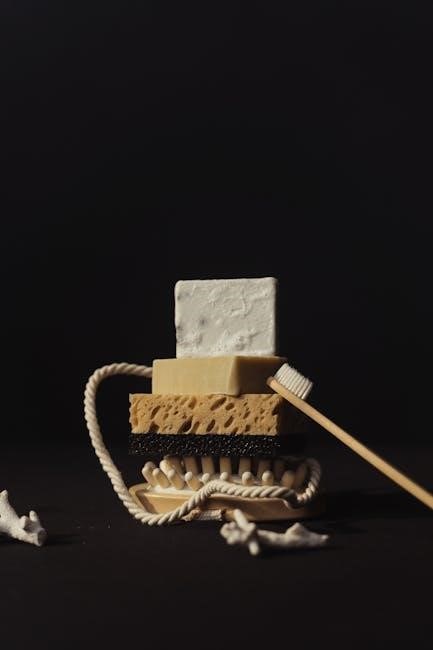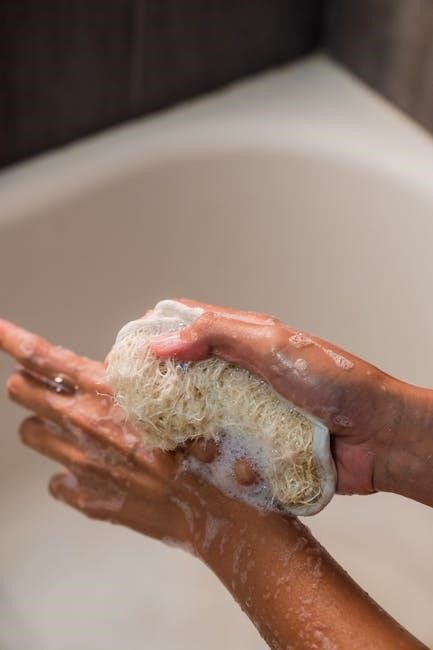Proper quilt washing is essential to preserve fabric integrity and color vibrancy. Use cold water, gentle detergents, and consider hand washing for delicate quilts. Always check care labels for specific instructions.
Overview of Quilt Washing
Washing a quilt requires careful consideration to preserve its fabric, stitching, and color. Start by inspecting the quilt for any damage or stains. If unsure, hand washing is generally safer, especially for delicate or antique quilts. For hand washing, use a large tub or bathtub with cold water and a small amount of gentle detergent. Soak the quilt overnight to loosen dirt. Gently agitate the water to release dirt, then rinse thoroughly by draining and refilling the tub. For machine washing, use a gentle cycle with cold water and a mild detergent. Avoid overloading the machine to prevent stretching or tearing. After washing, gently press out excess water without wringing. Air drying is recommended; lay the quilt flat on towels, ensuring it dries completely to prevent mildew. For spot cleaning, use a damp cloth or mild soap to address stains. To preserve colors, consider adding vinegar or salt during the wash or rinse cycle. Using color catcher sheets can help prevent dye bleeding.
Factors to Consider Before Washing
Before washing your quilt, assess its condition and history. Check for any tears, loose stitching, or fragile fabrics that may require special care. Antique or handmade quilts may need professional cleaning or hand washing to prevent damage. Always inspect the care label for specific instructions, as some quilts may require dry cleaning or have specific detergent recommendations. Consider the age of the quilt; older quilts may be more prone to color bleeding or fabric weakening. If the quilt has sentimental value, consulting a textile expert is advisable. Additionally, evaluate the quilt’s usage; frequently used quilts may need washing more often, while seasonal quilts can be cleaned less frequently. For quilts with bright colors or hand-dyed fabrics, using color catcher sheets can prevent dye transfer. Using cold water and gentle detergents is crucial to maintain fabric integrity and prevent fading. Avoid harsh chemicals or hot water, as they can damage the quilt’s materials and stitching. Finally, determine whether hand washing or machine washing is more appropriate based on the quilt’s sturdiness and care instructions.

How to Wash Your Quilt
Begin by checking the care label for specific instructions. Use cold water and a gentle detergent for both hand and machine washing. Consider adding color catcher sheets to protect colors.
Checking the Care Label
Before washing your quilt, it is crucial to examine the care label for specific instructions. Many quilts, especially handmade or vintage ones, may require special attention. The label may recommend machine washing on a gentle cycle or suggest hand washing. Some quilts might even advise against machine washing entirely, recommending professional cleaning instead. Additionally, the label may provide guidance on water temperature, detergent type, and drying methods. Ignoring these instructions could lead to damage, such as color bleeding, fabric shrinkage, or thread breakage. Always prioritize the manufacturer’s or creator’s recommendations to ensure the quilt remains in optimal condition. If the care label is missing or unclear, it is best to err on the side of caution and opt for a gentle hand-washing method or consult a professional cleaner. This step ensures your quilt remains a cherished item for years to come.
Pre-Wash Inspection and Preparation
Before washing your quilt, conduct a thorough inspection to identify stains, loose threads, or areas of wear. This step helps prevent further damage during the washing process. Inspect both the front and back of the quilt, paying attention to seams and edges. For stains, gently blot them with a clean, damp cloth to loosen dirt. Avoid rubbing, as this could damage the fabric. If the quilt has embellishments like beads or embroidery, ensure they are securely attached. Loose threads should be trimmed to prevent unraveling. For brightly colored or hand-dyed fabrics, consider using color catcher sheets in the wash to prevent dye transfer. Always remove any loose items like buttons or ties that could snag or break during washing. Proper preparation ensures a safer and more effective cleaning process, preserving the quilt’s integrity and appearance.
Hand Washing Your Quilt
Hand washing is a gentle and effective method for cleaning delicate or heirloom quilts. Start by filling a clean, deep sink or bathtub with cold water and adding a small amount of mild, dye-free detergent. Submerge the quilt, allowing it to soak for about 15 minutes to loosen dirt. Gently agitate the water with your hands to work the soap into the fabric, being careful not to scrub or wring the quilt, as this could damage stitching or cause colors to bleed. Rinse thoroughly by draining and refilling the tub until the water runs clear. Press out excess water without twisting or squeezing. For added color preservation, add a cup of white vinegar to the rinse water. Lay the quilt flat on clean towels to air dry, avoiding direct sunlight. Hand washing is ideal for preserving the integrity and beauty of your quilt.

Machine Washing Your Quilt
Machine washing a quilt can be a convenient option, but it requires careful attention to detail to avoid damage. Start by ensuring your washing machine is large enough to accommodate the quilt without overcrowding, as this can cause stretching or tearing. Use a gentle or delicate cycle with cold water to protect colors and fabric integrity. Add a small amount of mild, dye-free detergent to prevent color bleeding. Placing the quilt in the machine alone is recommended to avoid potential dye transfer from other fabrics. For extra precaution, include a color catcher sheet to absorb any excess dye. Avoid using high heat, as it can shrink fabrics or damage stitching. After the cycle, gently remove excess water without wringing or twisting. Machine washing is best suited for sturdy, commercially made quilts, while delicate or heirloom quilts may still benefit from hand washing. Always check the care label for specific machine washing recommendations.
Spot Cleaning Stains
Spot cleaning is an effective method for addressing specific stains on your quilt without the need for a full wash. Begin by identifying the type of stain to determine the best cleaning approach. For most stains, mix a small amount of mild liquid detergent or baby shampoo with cold water to create a gentle cleaning solution. Gently apply the solution to the stained area using a clean, soft cloth or a toothbrush, working from the outside in to prevent spreading the stain. Blot the area with a damp cloth to remove the solution and lift the stain. Avoid rubbing, as this can damage the fabric or batting. Repeat the process until the stain is removed, then allow the area to air dry completely. For stubborn odors, a light mist of distilled white vinegar can be applied before blotting. Spot cleaning is ideal for maintaining the quilt’s condition between full washes and preserving its delicate materials.
Using Cold Water and Gentle Detergents
Using cold water and gentle detergents is crucial when washing quilts to protect their fabrics, colors, and stitching. Cold water helps preserve the vibrancy of dyes and prevents shrinkage, while gentle detergents minimize the risk of damaging delicate materials. Avoid harsh chemicals or bleach, as they can weaken fibers or cause fading; Opt for a dye-free, scent-free detergent to ensure colors remain intact and to avoid irritating sensitive skin. For hand washing, dissolve the detergent thoroughly in cold water before adding the quilt. In machine washing, select a gentle cycle with cold water and a mild detergent specifically designed for washing fabrics like cotton or wool. This approach ensures the quilt remains soft, vibrant, and well-preserved for years to come. Always prioritize cold water to maintain the quilt’s integrity and extend its lifespan.
Adding Salt or Vinegar for Color Preservation
Add salt or vinegar to your quilt wash for enhanced color preservation and freshness. Salt helps lock colors and prevent bleeding, especially for vibrant or hand-dyed fabrics. Add half a cup during the wash cycle. Vinegar, meanwhile, balances pH levels, removes odors, and softens fabrics. Use a cup in the rinse cycle to maintain color brightness and eliminate lingering smells. Both methods are gentle and effective, ensuring your quilt retains its appearance without harsh chemicals. These natural additives are ideal for preserving heirloom or vintage quilts, protecting them from fading and damage. Incorporate salt or vinegar into your routine to keep your quilt looking its best and extend its longevity. Safe for most fabrics, these solutions are eco-friendly alternatives to commercial products. Always test a small area first to ensure no adverse reactions, especially on sensitive materials.
Using Color Catcher Sheets
Color catcher sheets are a simple yet effective way to protect your quilt from dye bleeding during washing. These sheets absorb excess dye from fabrics, especially useful for quilts with vibrant or hand-dyed materials. Place one or more sheets in the wash cycle, depending on the risk of color transfer. For front-load washing machines, it’s recommended to put the sheets in a mesh laundry bag to ensure they function properly. This method is particularly beneficial for quilts with red, blue, or deeply colored fabrics, which are prone to running. Using color catchers helps maintain the quilt’s appearance and prevents unwanted color mixing. Continue using them until the sheets come out clean, indicating minimal dye residue. This practice is especially valuable for preserving heirloom or vintage quilts, ensuring their colors remain vibrant for years to come. It’s a small step that makes a significant difference in maintaining your quilt’s beauty and longevity.

Drying Your Quilt
Drying your quilt requires care to prevent shrinkage and damage. Air drying is recommended, while tumble drying on low heat can also be used. Gently remove excess water, lay flat, or use a rack to ensure even drying and maintain shape. Avoid hanging wet quilts to prevent stretching or tearing. Always prioritize airflow to prevent mildew and ensure the quilt remains soft and intact.
Air Drying Your Quilt
Air drying is the safest method to preserve your quilt’s quality. Lay it flat on a clean, dry surface, such as a large towel or drying rack, ensuring even airflow. Avoid direct sunlight to prevent fading. Gently reshape the quilt to its original dimensions while damp. For quicker drying, place it in a well-ventilated area or use a fan. Never hang a wet quilt, as the weight can stretch or damage the seams. If drying indoors, avoid humid spaces to prevent mildew. Air drying maintains the quilt’s softness and prevents shrinkage, ensuring it remains vibrant and intact for years to come. This method is especially recommended for antique, handmade, or heavily embroidered quilts that require extra care.
Tumble Drying on Low Heat
Tumble drying on low heat is a convenient option for quilts, but it requires careful attention to prevent damage. Before drying, remove as much excess water as possible by gently squeezing or using a quick spin cycle; Place the quilt in a large-capacity dryer to ensure it has enough space to move freely, avoiding overcrowding. Use a low heat setting to prevent shrinkage and color fading. Adding dryer balls can help separate the quilt’s layers and reduce drying time. Remove the quilt while it’s still slightly damp and lay it flat to air dry completely. Avoid high heat, as it can damage fabrics and batting. For delicate or vintage quilts, tumble drying is not recommended. Always check the care label for specific instructions, as some quilts may require exclusive air drying to maintain their integrity.
Important Drying Tips
Proper drying is crucial to maintain the quality and appearance of your quilt. Always remove excess water gently before drying to prevent stretching or damage. For air drying, lay the quilt flat on a clean, dry surface, such as a large towel or drying rack, ensuring it’s fully expanded. Avoid hanging quilts from clotheslines or rods, as the weight can cause seams to weaken or tear. If using a tumble dryer, set it to low heat and remove the quilt while still damp to finish air drying. Never dry quilts in direct sunlight, as it can fade colors and weaken fabrics. Use a fan to speed up the drying process if needed. For delicate or antique quilts, air drying is the safest option. Regularly flipping the quilt ensures even drying and prevents mildew. Store the quilt only when completely dry to avoid moisture buildup and odors.

Maintaining Your Quilt

Regular maintenance ensures your quilt remains vibrant and durable. Store it in a cool, dry place, away from direct sunlight, and consider using acid-free tissue paper for protection. Rotate displayed quilts periodically to prevent wear and tear, and avoid folding them for extended periods to maintain their shape. For long-term storage, lay quilts flat or roll them gently, separating layers with clean fabric to prevent dye transfer. Inspect stored quilts regularly for signs of moisture or pests. Spot clean stains immediately and avoid using harsh chemicals. Vacuum with a gentle attachment or use a lint roller to remove dust and pet hair. Professional cleaning is recommended for antique or heirloom quilts. To freshen without washing, air out the quilt outdoors, away from direct sunlight, or lightly spray with distilled white vinegar. Consider adding a hanging sleeve for easy display rotation. Proper care extends the life of your quilt, preserving its beauty for future generations. Always handle with clean hands to prevent oil transfer, and avoid eating or drinking near the quilt to prevent spills. For quilts with embellishments like beads or embroidery, handle with extra care to avoid damage. Lastly, educate family members on proper quilt care to ensure it remains a cherished possession.
Storage Tips for Quilts
To maintain your quilt’s condition, store it in a cool, dry place away from direct sunlight and moisture. Avoid folding quilts for extended periods, as this can cause creases and stress on the fabric. Instead, lay quilts flat or roll them gently, placing a clean, cotton sheet or acid-free tissue paper between layers to prevent dye transfer. For long-term storage, consider using a breathable storage bag or wrapping the quilt in clean, white cotton fabric. Keep quilts away from pests by storing them in a clean, dry environment. Rotate quilts on display to ensure even wear and tear. For heirloom or antique quilts, consult a professional before storing, as they may require special care. Always handle quilts with clean hands to prevent oil transfer, and avoid storing them in attics or basements prone to humidity or pests. Proper storage ensures your quilt remains a cherished possession for generations.
Preventing Dust and Odors
To prevent dust and odors on your quilt, regularly shake it outdoors or use a lint roller to remove loose particles. For stubborn dust, gently vacuum the surface using a hose covered with nylon pantyhose. Avoid direct sunlight, as it can fade colors. For odors, lightly spray with distilled white vinegar and air-dry. Store quilts in a well-ventilated area, away from moisture. Rotate displayed quilts periodically to reduce dust accumulation. Consider using breathable storage bags or wrapping in cotton fabric to maintain freshness. Spot clean stains promptly to prevent odor buildup. Washing should be minimized, especially for delicate quilts, to preserve fabric integrity. Use a mild detergent and cold water when necessary. Air-drying is recommended to avoid shrinkage and damage from heat. Regular maintenance ensures your quilt remains fresh and vibrant, preserving its beauty and longevity for years to come.
Professional Cleaning Options
For valuable, antique, or delicate quilts, professional cleaning is highly recommended. Experts use specialized techniques to preserve intricate stitching, embellishments, and historical fabric integrity. They assess the quilt’s condition, identifying fragile areas and potential color bleeding risks. Hand washing or dry cleaning may be employed, depending on the quilt’s materials and age. Professional cleaners often use pH-neutral detergents to protect dyes and fabrics. They may also apply conservation methods to prevent further deterioration. Consulting a quilt museum, textile expert, or trusted conservator ensures your quilt receives the care it deserves. Professional cleaning is especially crucial for heirloom quilts with sentimental or monetary value. Regular home maintenance can prevent the need for frequent professional cleaning, but when necessary, experts provide the safest and most effective care for your treasured quilts, ensuring they remain vibrant for generations.
Frequency of Washing
The frequency of washing a quilt depends on its usage and condition. Quilts used seasonally or for display should be washed once a year or before storage. Those used daily benefit from seasonal washing to remove accumulated dust and odors. Over-washing can degrade fabrics and batting, so it’s essential to balance cleanliness with preservation. For heirloom or antique quilts, washing should be avoided unless necessary, as excessive cleaning can damage delicate materials. Spot cleaning is often a safer alternative. Always check for care labels, but if unsure, err on the side of caution. Proper storage and regular airing can reduce the need for frequent washing, helping maintain your quilt’s integrity and longevity.
Proper quilt washing preserves their beauty and longevity; Use cold water, gentle detergents, and avoid over-washing. Always check care labels and consider professional cleaning for heirlooms. Thoughtful care ensures quilts remain treasured for generations.
Importance of Proper Quilt Care
Proper quilt care is essential to maintain their beauty, functionality, and longevity. Washing quilts incorrectly can lead to fabric fading, thread damage, and batting disintegration. Hand washing or using a gentle machine cycle with cold water and dye-free detergents helps preserve colors and stitching. Adding vinegar or salt during washing can prevent dye bleeding and maintain vibrancy. Spot cleaning stains instead of washing the entire quilt minimizes wear and tear. Avoiding frequent washing unless necessary protects delicate fabrics and embroidery. Regularly airing out quilts and storing them properly prevents dust and odors. For heirloom or antique quilts, professional cleaning is often recommended to ensure safety. By following these care practices, quilts can remain soft, colorful, and intact for generations, serving as cherished family heirlooms or everyday comforts. Proper care not only extends their lifespan but also preserves their sentimental value.
